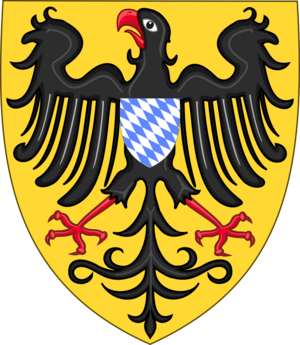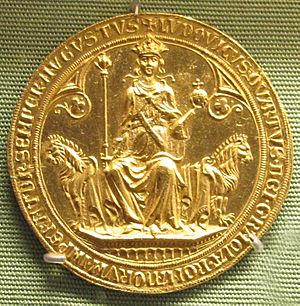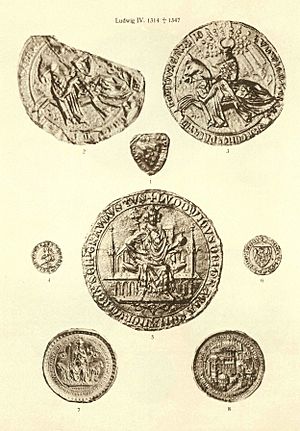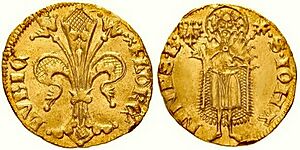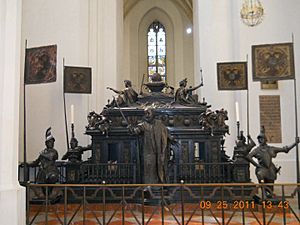Louis IV, Holy Roman Emperor facts for kids
Quick facts for kids Louis IV |
|
|---|---|
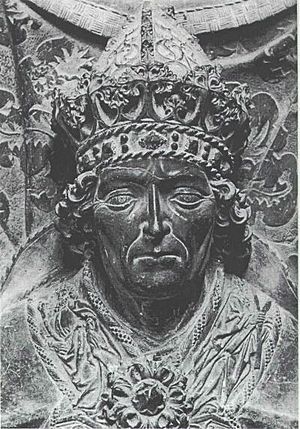
Tomb effigy at Munich Frauenkirche
|
|
| King of the Romans until 1330 with Frederick the Handsome |
|
| Reign | 20 October 1314 – 11 October 1347 |
| Coronation | 25 November 1314 (Aachen) |
| Predecessor | Henry VII |
| Successor | Charles IV |
| King of Italy | |
| Reign | 31 May 1327 – 11 October 1347 |
| Coronation | 31 May 1327 (Milan) |
| Predecessor | Henry VII |
| Successor | Charles IV |
| Holy Roman Emperor | |
| Reign | 1328 – 11 October 1347 |
| Coronation | 17 January 1328 (Rome) |
| Predecessor | Henry VII |
| Successor | Charles IV |
| Duke of Bavaria until 1317 with Rudolf I |
|
| Reign | 1301 – 11 October 1347 |
| Predecessor | Rudolf I |
| Successor | Louis V, Stephen II, Louis VI, William I, Albert I and Otto V |
| Born | 1 April 1282 Munich |
| Died | 11 October 1347 (aged 65) Puch, near Fürstenfeldbruck |
| Spouse | Beatrix of Świdnica Margaret II, Countess of Holland |
| Issue | Matilda, Margravine of Meissen Louis V, Duke of Bavaria Stephen II, Duke of Bavaria Louis VI, Duke of Bavaria William I, Duke of Bavaria Albert I, Duke of Bavaria Beatrice, Queen of Sweden Otto V, Duke of Bavaria |
| House | Wittelsbach |
| Father | Louis II, Duke of Bavaria |
| Mother | Matilda of Habsburg |
| Religion | Roman Catholicism |
Louis IV (born April 1, 1282 – died October 11, 1347), also known as Louis the Bavarian, was an important ruler from the House of Wittelsbach. He became the King of the Romans in 1314, King of Italy in 1327, and finally the Holy Roman Emperor in 1328.
His journey to becoming king was not easy. In 1314, two different groups of important nobles, called electors, chose two different kings. One group chose Louis, and the other chose his cousin, Frederick the Fair. This led to a long and difficult conflict. Louis eventually defeated Frederick in 1322, and they later became friends. Louis also had many disagreements with the Pope John XXII, who even tried to remove him from power.
Louis IV held many titles during his life. He was the Duke of Upper Bavaria from 1294/1301. He also ruled as Margrave of Brandenburg until 1323 and Count Palatine of the Rhine until 1329. In 1340, he became the Duke of Lower Bavaria. Later, in 1345, he gained control of several other areas like Hainaut, Holland, Zeeland, and Friesland because his wife, Margaret, inherited them.
Contents
Early Life and Becoming a Duke
Louis was born in Munich. His father was Louis II, the Duke of Upper Bavaria, and his mother was Matilda, who was the daughter of King Rudolph I.
Louis received some of his education in Vienna. In 1301, he became a co-ruler of Upper Bavaria with his older brother, Rudolf I. He had the support of his mother and her brother, King Albert I. However, Louis soon started to argue with the Habsburg family over land in Lower Bavaria.
He also had a civil war against his own brother Rudolf over how their lands should be divided. This conflict ended in 1313 with a peace agreement in Munich.
In the same year, Louis won an important battle on November 9, 1313. He defeated his cousin, Frederick the Fair, in the Battle of Gammelsdorf. Frederick was supported by Duke Leopold I. This victory was a big deal in the Holy Roman Empire and made Louis much more respected.
Becoming King and Fighting Frederick
When the Holy Roman Emperor Henry VII died in 1313, a new king needed to be chosen. Many nobles thought Henry's son, John, was too young or already too powerful. So, some chose Frederick the Fair.
However, another group of electors, who supported the Luxembourg family, decided to choose Louis instead. They wanted to stop Frederick from becoming king.
On October 19, 1314, four electors chose Frederick as king. But the next day, five different electors met and chose Louis as king. Louis was crowned in Aachen, which was the traditional place for coronations. Frederick was crowned in Bonn. This double election led to a long and bloody war between the two kings.
After several years of fighting, Frederick seemed to be winning. But Louis's army won a major victory at the Battle of Mühldorf on September 28, 1322. Louis captured Frederick and many other important nobles.
Louis kept Frederick as a prisoner for three years. However, Frederick's brother Leopold continued to fight, and John of Bohemia stopped supporting Louis. Also, Pope John XXII officially removed Louis from the church in 1324. This made Louis decide to release Frederick in 1325. Frederick promised to recognize Louis as the rightful ruler and would return to prison if he couldn't convince his brothers to accept Louis.
Frederick could not convince his brother Leopold, so he returned to Louis as a prisoner. Louis was so impressed by Frederick's honor that they became friends again. They even agreed to rule the Empire together. But the Pope and the electors did not like this idea. So, in 1326, they made another agreement: Frederick would rule Germany as King of the Romans, and Louis would be crowned Emperor in Italy. After Leopold died in 1326, Frederick stopped ruling the Empire and went back to just ruling Austria. He died in 1330.
Becoming Emperor and Conflicts with the Pope
After making peace with the Habsburgs, Louis traveled to Italy. In 1327, he was crowned King of Italy in Milan. He had already sent an army to Italy in 1323 to protect Milan from the Kingdom of Naples, which was a strong ally of the Pope.
In January 1328, Louis entered Rome. He was crowned Emperor by an old senator named Sciarra Colonna. A few months later, Louis declared that Pope John XXII, who lived in Avignon, was no longer Pope. Louis then chose a new Pope, Pietro Rainalducci, who became Antipope Nicholas V. However, this new Pope soon left Rome and later gave up his claim.
Louis had many supporters who were also against the Pope, including important thinkers like Michael of Cesena, William of Ockham, and Marsilius of Padua. They joined Louis at his court in Alter Hof in Munich, which became an important center for the Holy Roman Empire.
In 1337, Emperor Louis made an alliance with King Edward III of England. They joined forces against King Philip VI of France, who was protecting the new Pope, Pope Benedict XII. King Philip VI had prevented any peace talks between Louis and the Pope. Because of this, in 1338, six electors declared that a king chosen by most electors automatically had the right to rule the Empire, without needing the Pope's approval. King Edward III even visited Louis in Koblenz and was named Louis's special representative for the Holy Roman Empire.
Supporting Cities and Expanding Power
Louis IV was a strong supporter of the Teutonic Knights, a military and religious order. He also focused on helping cities in the Empire grow and become stronger. Many city records mention the special rights he gave them. For example, in 1330, he allowed the Frankfurt Trade Fair to happen. In 1340, Lübeck, a powerful city that would later be part of the Hanseatic League, was given the right to make its own golden coins.
Louis also worked to increase his family's power and lands. In 1323, he gave Brandenburg to his oldest son, Louis V. In 1329, he made peace with his late brother Rudolf's sons and gave them back the Palatinate. In 1340, Louis inherited Lower Bavaria, bringing the whole duchy of Bavaria back together.
In 1342, Louis also gained Tyrol for his family. He arranged for his son Louis V to marry Margarete Maultasch, which upset the Luxembourg family even more. In 1345, he further angered other princes by giving Hainaut, Holland, Zeeland, and Friesland to his wife, Margaret II. He did this even though Margaret's sisters, including the Queen of England, had claims to these lands. Louis was determined to make his family's power base stronger.
Final Conflict and Death
Because Louis had expanded his power so much, he made many enemies among the German princes. In 1346, the Luxembourg family supported Charles IV as a rival king. Charles was also supported by Pope Clement VI. Many people called Charles a "papal puppet."
Louis, however, had a lot of support from the free cities and knights, and he was able to resist Charles. The Habsburg dukes also remained loyal to Louis. In the Battle of Crécy, Charles's father, John of Luxemburg, was killed. Charles himself was in the battle but managed to escape.
A longer civil war was avoided because Louis died suddenly in October 1347. He suffered a stroke while hunting bears near Fürstenfeldbruck. He is buried in the Frauenkirche in Munich. After his death, Louis's sons supported another rival king, but they eventually joined Charles's side. The Wittelsbach family, Louis's family, would later return to power in the Holy Roman Empire in 1400 with King Rupert of Germany.
Family Life
Louis IV was married twice and had many children.
His first wife was Beatrix of Świdnica (1290-1320), whom he married in 1308. They had several children, including:
- Mathilde (born 1313)
- Louis V the Brandenburger (born 1316), who became Duke of Upper Bavaria and Margrave of Brandenburg.
- Stephen II (born 1319), who became Duke of Lower Bavaria.
In 1324, he married his second wife, Margaret II, Countess of Hainaut and Holland (1308-1356). They also had many children, including:
- Louis VI the Roman (born 1328), who became Duke of Upper Bavaria.
- William V of Holland (born 1330), who became Duke of Lower Bavaria and Count of Hainaut.
- Albert I of Holland (born 1336), who became Duke of Lower Bavaria and Count of Hainaut.
- Otto V the Bavarian (born 1340/42), who became Duke of Upper Bavaria.
- Beatrix (born 1344), who became Queen of Sweden.
Images for kids
See also
 In Spanish: Luis IV de Baviera para niños
In Spanish: Luis IV de Baviera para niños



